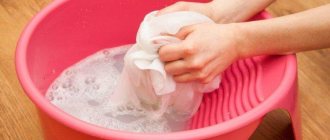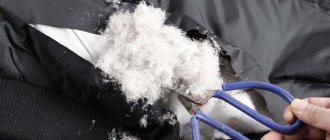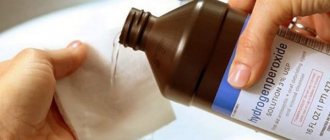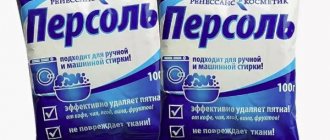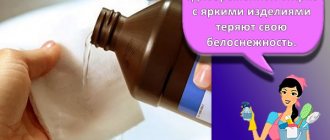Do you follow all the instructions when washing clothes in the machine, but have you repeatedly noticed that white items turn gray after washing? The site sympaty.net knows how to wash so that this does not happen again, and how to bleach gray laundry.
The question is, what to do if white underwear has turned gray?
can be solved in several ways. The simplest answer for modern housewives is washing or soaking with ready-made oxygen bleach. But there are also effective folk methods for high-quality whitening at home - this is soaking or even boiling things in solutions of soda, peroxide, ammonia and other available and inexpensive substances.
Basic rules for washing white clothes
White fabric is quite capricious, so before washing you should learn the basic rules so as not to spoil things. By following these rules, you will keep your favorite blouse, T-shirt or underwear in their original form.
- Remember the most important thing - whites are washed separately from colored ones! Once in the wash with colored items, your white item will definitely become stained.
- Pay attention to what fabric your items are made of, since cotton and silk require different washing conditions and cannot be washed together.
- When choosing a bleaching agent, it is also worth considering the type of fabric. Strong chemicals can damage delicate fabrics.
- It is better to wash white items by hand. This will cause less damage and allow you to rinse more thoroughly.
- When washing white clothes in an automatic machine, watch the drain so that the tube is not clogged, otherwise there will be streaks on the white clothes.
- Don't forget about the hardness of tap water. Use a variety of softeners, especially when washing delicate fabrics.
- If things are heavily soiled, first, soak them for several hours with the addition of powder or bleach, and only then throw them in the machine for regular washing. This will help you get rid of stains more effectively.
- White clothes love the sun, so try to dry them in the fresh air.
Following these rules and choosing high-quality detergents will keep your items white for a long time.
How to bleach a T-shirt after it has been dyed?
If
the item
colored
, take four tablespoons of soda and dissolve it in five liters of water. Stir the solution and soak the affected items for four to six hours. Rinse the material thoroughly and the color will go away with the water; To remove colored stains from cotton, use turpentine.
Interesting materials:
Who needs Victoria's declination? Who is harmful from kombucha? Who is harmful from cocoa? Who is the author of the song that hooked me? Who has measles? Who is more ticklish? Who will be my aunt's daughter? Who will be on Dancing with the Stars 2022? Who was Pushkin's grandfather? Who was the dean of Hufflepuff?
Clothes have faded
You followed all the rules, but your white clothes faded when washed. What to do? The main thing in such a situation is to quickly take the necessary measures. In fact, things can fade not only because of washing with colored items. It happens that a forgotten piece of paper in your pocket - a candy wrapper, a wrapper, a note - will stain your white things. In this case, you cannot do without strong bleaches.
It’s good that nowadays there is a huge selection of different brands of bleaches. But they are all divided into two types: oxygen-containing and chlorine-containing.
It is believed that chlorine has a more effective effect in terms of bleaching things, but only in the case of natural fabrics. The advantage of such bleaches is their disinfectant properties. Chlorine is excellent at killing germs and bacteria, so your items undergo additional treatment. For items made of silk and synthetics, it is advisable to use a permissible amount of chlorine-based bleach so as not to damage the fabric.
Oxygen-containing bleaches act by a chemical reaction. Oxygen crystals, when oxidized during washing, push organic substances out of the fabric of white items, while being gentle on the fibers of the fabric itself. Unlike chlorine-based products, oxygen bleaches can be used in washing machines. The effect of oxygen is much less than that of chlorine, but this product is more gentle on delicate fabrics.
Let's take a closer look at the example of two of the most famous representatives of household chemicals for whitening things.
- A representative of chlorine bleach is Whiteness.
Suitable not only for restoring faded items, but also for treating a room. The advantages are an affordable price and disinfectant properties. The downside is the strong chemical effect on the fabric. After frequent washing with white, the fibers become thinner and break.
It is forbidden to use Whiteness for silk and woolen items!
Another disadvantage of this product is that it cannot be used in a washing machine. Chlorine can damage parts and cause failure.
It should be remembered that chlorine is a chemical element that tends to evaporate. When using it, follow the rules and safety precautions to avoid burns and allergic reactions. Ventilate the room in which you wash and put on rubber gloves.
- A representative of oxygen-containing bleaches is Persol.
The advantage of this product is that it is suitable for any type of fabric due to its soft action. The oxygen contained in the composition, when exposed to contamination, does not spoil the fibers themselves. The characteristics of the bleach indicate that it can be used at any temperature. That is, it becomes possible to restore faded items even in cold water. Persalt can be used in washing machines and does not contain harsh chemicals that can cause allergies.
Under no circumstances should you experiment and mix two different bleaches to enhance the effect! This will definitely ruin your things.
Oxygen bleaches can also be used when washing children's clothes.
Now you know that white items that have not been washed correctly can be restored, but only with the use of professional products. But how to restore gray fabric?
Mold in the powder compartment or pipes
Such phenomena can be found in homes where washing machine maintenance was completely absent or was carried out incorrectly. As a rule, this also happens when a person, after finishing washing, closes the powder compartment and the drum, not allowing them to dry properly.
Mold is a “lover” of dampness and, if you add a warm environment to this factor, you can create almost ideal conditions for it to form a huge amount of black mold, which will begin to release a large number of harmful spores into the air.
Where does mold most often form in the “insides” of a washing machine:
- In the cuvette (compartment) for pouring washing powder;
- In the pipes that lead from the cuvette to the water tank;
- On the walls of the drum;
- On the cuff;
- Inside the water tank.
Anyone with a normal sense of smell will be able to determine the “presence” of mold - its smell will immediately give everything away. Just stick your head into the drum and the pungent “aroma” will immediately hit your nostrils.
This will be the main reason to take a closer look at the remaining components of the stirlak. The procedure is like this:
- Carefully bend the hatch cuff and inspect the cracks;
- Take a look at the walls of the drum;
- Look also in the compartment for filling the detergent;
- Remove the compartment and inspect its opening.
In most cases, you will quickly discover an extremely unpleasant-looking black “cap” that has begun to develop in your machine. And, when clothes come into contact with this mold, they “acquire” dark, smeared dirt.
If this is your situation, it needs to be resolved extremely quickly. To do this, pour 300 g of baking soda into the compartment, turn on the highest temperature setting, and run the machine “idle” with double rinsing.
Such an aggressive “washing” of the machine itself will allow you to forget about the unpleasant problem with mold for a long time. If after the first time it doesn’t work, that’s okay, the process can be repeated until the mold disappears completely.
Restoring gray fabric
Many housewives stop using washed and grayed white things, preferring to get rid of them, believing that it is impossible to return them to their former whiteness. But that's not true! Although this process is labor-intensive, it is possible to return the white color to things. Pay attention to what fabric they are made of and adhere to the following rules. Let's look at the example of guipure or similar fabric:
- Prepare a large basin and fill it with about ten liters of hot water.
- Add ammonia, about 50 ml, and the same amount of hydrogen peroxide. Stir everything well.
- Dip the grayed item into the prepared solution and wait 30 minutes.
- Then rinse the item in cold water and wash as usual.
Guipure fabric, or something similar to it, will again become snow-white. Using the same method, you can restore the white color to tulles, curtains and underwear. Remember to rinse well and use a water softener.
For items made of natural fabric, the usual method using bleaches is suitable, which will also return the white color to grayed items.
Synthetics are a type of fabric that cannot be bleached with chemicals. To restore the whiteness of synthetic items, use table salt. To do this, dissolve 40 g of salt in warm water.
If things are heavily soiled, you can use boric acid. It is added to the cleaning product in an amount of 25 ml and mixed in warm water, where white things are soaked.
When it comes to silk and wool, then only table salt is allowed.
The fact is that white things can turn gray not only due to improper washing, but also due to the quality of the water. Unfortunately, tap water contains various impurities of heavy metals, which give things a gray tint. A variety of water softeners are recommended, and baking soda is a great option to keep on hand.
But most importantly, try to wash white items after each wear. This way you will avoid the need to restore their whiteness in the future.
Recommendations
you wash white clothes without unpleasant consequences :
It is advisable to wash white items separately from items of other shades.- It is necessary to deal with stains on clothes before the main wash.
- Worn, light-colored clothes are more difficult to wash than those that have been worn 1-2 times.
- When boiling laundry, you must turn on the hood or open a window.
- It is recommended to wash items as they become dirty, without accumulating them for a long time.
- White items should not be stored in direct sunlight.
- Removing stains from items and hand washing should be done using rubber gloves.
- Spinning at high speeds leads to rapid wear of things.
For expensive exclusive items, dry cleaning can be used.
Removing yellow sweat stains
Unpleasant stains like sweat stains are difficult to remove. These stains are organic and difficult to remove, as they eat deep into the fiber structure of the fabric. Such stains can be completely removed only with aggressive chemicals, but there is a risk of damaging the fabric itself.
All that remains is to wash white items after each wear, especially in summer and winter.
If yellow spots appear in the armpit area, you can use:
- Chlorine – for linen and cotton items. Baking soda can also be used, but the effect will be less.
- Mustard powder, peroxide and ammonia - in the case of silk and wool.
- Table salt - in relation to synthetics. In order not to damage synthetic items, you will have to use only salt, of course it will take more time, but you can safely bleach this fabric.
- Soaking is a must for any fabric.
Before bleaching any item, first test your product on a small area of fabric to see the results. This way you will avoid many problems later.
Removing stains at home
Stains can completely ruin the effect of a white item. It is advisable to start removing them as early as possible so that the contaminants do not have time to be absorbed deeply into the fibers.
It is useful to know the origin of the stain in order to act as effectively as possible.
You can learn about ways to remove yellow stains of various origins from white things from this article.
Fat
You can try to remove a greasy stain in several ways . One of them is applying dishwashing detergent to the fabric. If you have white chalk on hand, you can crush it and sprinkle it on the greasy stain. The white powder will absorb fat particles.
Grass
Treating with alcohol will help remove traces of grass from the surface of the white material. If it is not available, you can use vodka.
Procedure:
- the stained area is soaked with an alcohol-containing liquid;
- leave the item for a quarter of an hour;
- rinse;
- washed.
To remove stains from white clothes, only alcohol and vodka are allowed, as other alcohol-containing drinks can stain the fabric.
Fruits
Berry and fruit stains are quite difficult to remove . If possible, the item should be washed immediately using washing powder. After treating the stain, soak the soiled clothing for half an hour and wash it as usual.
Blood and wine
Treatment with alcohol or hydrogen peroxide will help deal with wine or blood stains. After the active substance has taken effect, the product is rinsed and washed.
Do not use hot water, as this may cause permanent yellowish stains on the white background.
Read about how to remove red wine stains from white clothes here.
Sweat
There are several ways to remove sweat stains. You can do the following:
- Combine 1 tbsp in a bowl. soda and 1 tbsp. l. salt.
- Add 1 tsp. liquid soap.
- Stir.
- Apply to stains.
- Leave for half an hour.
- Wash.
Manual whitening
For the procedure you will need: a 5-liter basin or pan, a soft brush, the selected bleaching agent and the sweater itself.
We recommend: How to make pants one size smaller at the waist and sides
Step-by-step instruction:
- Wash the jacket in soapy water if it is dirty. If not, just wet and let the water drain.
- Prepare a bleaching solution and control the water temperature (should be between 30-40 degrees).
- Place the damp sweater in the solution and leave for half an hour. The duration of soaking is indicated as average - it is better to rely on the information indicated on the bleach packaging.
- Now all that remains is to rinse the sweater. But first, it is recommended to rub it with a brush or stroke it with your hands without squeezing it.
- Dry the jacket on a horizontal surface and only then evaluate the result (dry fabric looks an order of magnitude lighter than wet fabric).
For effective bleaching, the temperature of the solution must be maintained during soaking. To do this, you can cover the container with a lid and wrap it in a blanket or place it on a large pan of boiling water (steam bath effect).
Removing gray plaque from a blouse
The first thing you can use without fear of damage to the product is modern bleaches. They are sold on the shelves of hardware stores and are divided into several classes:
- chlorine-containing;
- oxygen;
- compositions for optical purposes.
Chlorine-containing bleaches can be used on rough and thick materials. These are products like Whiteness, which contain chlorine. When using such a substance with chiffon, there is a risk of damage to the white blouse.
Another subgroup of products with whitening properties is oxygen-based. This is a well-known Vanish product, the composition of which helps to whiten a blouse at home if there is a print of a bright shade. The components carefully preserve the white color of the product without affecting the paint of the design.
Optical compositions are designed to visually lighten your favorite sweater. They will not penetrate deep into the fibers, completely cleaning the material. These products are characterized by surface cleaning, so they are suitable for silk and chiffon.
In addition to household purchased products, folk methods will help you bleach a white blouse at home if it has turned grey. They are based on the use of improvised means that are affordable.
